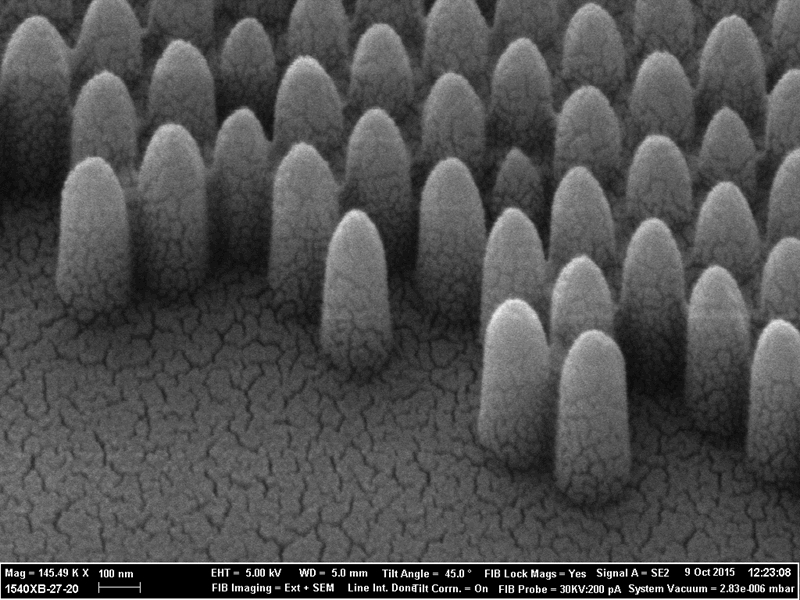 电子扫描显微镜下的玻璃纳米层结构。从纳米级别控制玻璃的表面形态,可以非常精确地控制玻璃与液体、光线间的互动。
电子扫描显微镜下的玻璃纳米层结构。从纳米级别控制玻璃的表面形态,可以非常精确地控制玻璃与液体、光线间的互动。 UCL大学“智能玻璃”解决方案原型。图中较暗区域采用了纳米结构,具有防水性,可以迫使水形成近似球形的水滴,快速流过玻璃。图中UCL字样的区域则并未经过特殊处理,我们可以注意到该区域的反射要强的多。
UCL大学“智能玻璃”解决方案原型。图中较暗区域采用了纳米结构,具有防水性,可以迫使水形成近似球形的水滴,快速流过玻璃。图中UCL字样的区域则并未经过特殊处理,我们可以注意到该区域的反射要强的多。 UCL大学的Ioannis Papakonstantinou指出,这是纳米结构与感温变色涂层的首次结合。
UCL大学的Ioannis Papakonstantinou指出,这是纳米结构与感温变色涂层的首次结合。
优化驾驶员的视野,是提升车辆安全性的重要课题。虽然如今的汽车已经开始越来越依赖立体照相机、激光雷达和红外系统等电子系统,但从本质而言,优化视野的关键仍在于清洁的车窗,这样驾驶员才能看清车外的情况。
如今,英国一所大学的研究人员推出了一种适用于建筑窗户的“智能”玻璃解决方案,可能也同时适用于车辆车窗。这种玻璃采用了纳米技术,不但可以实现自动清洁,而且还具有节能环保和防眩光的属性。
“这是纳米结构与感温变色涂层的首次结合,”英国伦敦大学学院(University College London,下简称UCL大学)电子与电气工程系Ioannis Papakonstantinou博士表示,“这种仿生纳米结构可以增强玻璃涂层的感温变色属性,带来一种能够实现自动清洁的高性能智能窗户。”
作为该高级专家团队的项目主管,Papakonstantinou表示,这种纳米结构的初步应用为摩天大楼的外窗,但目前他也认为,只要符合汽车行业的安全标准和其他规定,这种技术也完全可以用于道路汽车。
“我们应当将这种技术的应用范围推广至汽车领域,这很容易,只是涂一层1毫米左右的涂层而已。当然了,我们肯定还要建立一套测试项目,比如观察水滴流下车窗玻璃的速度快慢,这点非常重要,特别是针对前挡风窗而言。”
UCL大学的研究工作得到了英国工程与自然科学研究理事会(Engineering and Physical Sciences Research Council)的资金支持。据称,经过实验证明,该结构确实可以表现出3种优良属性。
具体来说,当雨水接触到这种纳米玻璃表面后会形成水珠,而后在流过玻璃的过程中带走灰尘、泥土等污染物,这就是自动清洁功能的原理。Papakonstantinou解释说:“这主要是由于玻璃上的纳米结构具有像铅笔尖一样的圆锥形设计,可以存储空气,从而在很大程度上减少液体与玻璃表面的接触。”
与这种新型玻璃不同的是,当雨滴落在常规玻璃上时,一般会在玻璃表面停留一段时间,而后才会滑落,并且还会留下印记。
为了达到节能效果,这种玻璃的表面还涂了一层5到10纳米厚的二氧化钒(一种便宜丰富的材料)薄膜,这可以减少热损耗,并在炎热天气中减少射入车内的太阳辐射。
“这种纳米结构还具有防眩光的属性,这种能力多见于蛾子或其他善于躲避捕食者的生物之中。”Papakonstantinou指出,“这种新玻璃可以将室内反射光线控制在5%之内,而其他二氧化钒膜节能窗户的平均表现为20%-30%。”
他强调说,目前UCL大学的发现仍处于研究成果阶段,下一步的主要任务是优化纳米制造技术和二氧化钒涂层工艺,以支持规模化生产。目前,Papakonstantinou已经从欧洲研究委员会(European Research Council)敲定了180万欧元的经费,用于实现这一目标。
此外,UCL大学的团队成员还包括该校化学系教授Ivan Parkin,以及电子与电气工程系研究员Alaric Taylor。
作者:Stuart Birch
来源:SAE《汽车工程杂志》
翻译:SAE 上海办公室
Nanotechnology may provide self-cleaning, energy-saving 'smart glass' for vehicles
Improving driver visibility is a major aspect of vehicle safety that is increasingly supported by stereo cameras, LiDAR, and infrared systems. But fundamental to visibility is being able to see clearly through clean glass windows, and front and rear windshields.
Now, researchers at a U.K. university have revealed a "smart" window solution for buildings that may also be applicable to vehicles. It uses nanotechnology to achieve not only self-cleaning but also delivers energy saving and anti-glare properties.
“This is the first time that a nanostructure has been combined with a thermochromic coating,” said Dr. Ioannis Papakonstantinou of the Department of Electronic and Electrical Engineering, University College London (UCL). “The bio-inspired nanostructure amplifies the thermochromic properties of the coating, and the net result is a self-cleaning, highly performing smart window.”
As project leader of a highly specialist team, Papakonstantinou said initial applications of nanostructures could be to skyscraper windows but at present he believes that in theory there was no reason why the system could not be extrapolated to road vehicles provided it met required safety standards and other legislation.
“It should, because it simply involves application of a coating of about one micron. But of course there would need to be a test program to establish—for example, how quickly water droplets would flow down automotive glass, particularly the windshield.”
The research work at UCL is being supported by the U.K.’s Engineering and Physical Sciences Research Council, and prototype examples of the technology are said to confirm that the three key benefits can be delivered.
The self-cleaning application sees rain hitting a glass surface to form spherical droplets that roll easily across that surface carrying away dust, dirt, and any other contaminants. Explained Papakonstantinou: “This is due to the pencil-like, conical design of nanostructures engraved onto the glass, trapping air and ensuring that only a tiny amount of water comes into contact with the surface.”
Regular glass typically sees raindrops clinging to the surface before sliding down, leaving marks.
To achieve energy saving, a glass surface is coated with a 5- to 10-nm (0.2- to 0.4-µin) film of vanadium dioxide (a cheap and abundant material), which prevents heat loss or, in hot climates, prevents solar IR entering the vehicle.
“The design of the nanostructures also gives the windows the same anti-reflective properties found in the eyes of moths and other creatures to hide them from predators!” noted Papakonstantinou. “It cuts the amount of light reflected internally in a room to less than 5% compared to 20-30% achieved by other prototype vanadium-dioxide-coated energy saving windows.”
He stressed that the UCL findings are the result of a research project and that the next big step would be to scale-up the nano manufacturing techniques and the vanadium-dioxide coating process used to create the prototypes. For this purpose, Papakonstantinou has secured a €1.8M grant from the European Research Council.
The UCL team also includes Prof. Ivan Parkin of the university’s Department of Chemistry, and researcher Alaric Taylor of the Department of Electronic and Electrical Engineering.
Author: Stuart Birch
Source: SAE Automotive Engineering Magazine
等级
打分
- 2分
- 4分
- 6分
- 8分
- 10分
平均分
